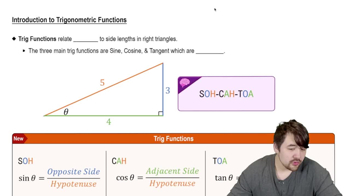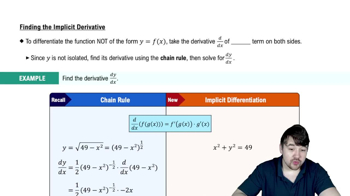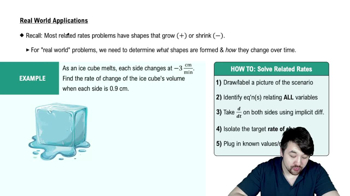Table of contents
- 0. Functions7h 52m
- Introduction to Functions16m
- Piecewise Functions10m
- Properties of Functions9m
- Common Functions1h 8m
- Transformations5m
- Combining Functions27m
- Exponent rules32m
- Exponential Functions28m
- Logarithmic Functions24m
- Properties of Logarithms34m
- Exponential & Logarithmic Equations35m
- Introduction to Trigonometric Functions38m
- Graphs of Trigonometric Functions44m
- Trigonometric Identities47m
- Inverse Trigonometric Functions48m
- 1. Limits and Continuity2h 2m
- 2. Intro to Derivatives1h 33m
- 3. Techniques of Differentiation3h 18m
- 4. Applications of Derivatives2h 38m
- 5. Graphical Applications of Derivatives6h 2m
- 6. Derivatives of Inverse, Exponential, & Logarithmic Functions2h 37m
- 7. Antiderivatives & Indefinite Integrals1h 26m
- 8. Definite Integrals4h 44m
- 9. Graphical Applications of Integrals2h 27m
- 10. Physics Applications of Integrals 2h 22m
4. Applications of Derivatives
Related Rates
Problem 3.11.45
Textbook Question
Watching an elevator An observer is 20 m above the ground floor of a large hotel atrium looking at a glass-enclosed elevator shaft that is 20 m horizontally from the observer (see figure). The angle of elevation of the elevator is the angle that the observer’s line of sight makes with the horizontal (it may be positive or negative). Assuming the elevator rises at a rate of 5 m/s, what is the rate of change of the angle of elevation when the elevator is 10 m above the ground? When the elevator is 40 m above the ground? <IMAGE>
 Verified step by step guidance
Verified step by step guidance1
Step 1: Define the variables. Let \( \theta \) be the angle of elevation, \( y \) be the height of the elevator above the ground, and \( x \) be the horizontal distance from the observer to the elevator shaft, which is constant at 20 m.
Step 2: Use trigonometry to relate \( \theta \) and \( y \). The tangent of the angle \( \theta \) is given by \( \tan(\theta) = \frac{y}{x} \). Since \( x = 20 \) m, we have \( \tan(\theta) = \frac{y}{20} \).
Step 3: Differentiate both sides of the equation \( \tan(\theta) = \frac{y}{20} \) with respect to time \( t \). Use the chain rule: \( \sec^2(\theta) \frac{d\theta}{dt} = \frac{1}{20} \frac{dy}{dt} \).
Step 4: Substitute the given rate of change of the elevator's height, \( \frac{dy}{dt} = 5 \) m/s, into the differentiated equation: \( \sec^2(\theta) \frac{d\theta}{dt} = \frac{1}{20} \times 5 \).
Step 5: Solve for \( \frac{d\theta}{dt} \) when \( y = 10 \) m and \( y = 40 \) m. First, find \( \theta \) using \( \tan(\theta) = \frac{y}{20} \) for each case, then calculate \( \sec^2(\theta) \), and finally find \( \frac{d\theta}{dt} \) using the equation from Step 4.
 Verified video answer for a similar problem:
Verified video answer for a similar problem:This video solution was recommended by our tutors as helpful for the problem above
Video duration:
6mPlay a video:
Was this helpful?
Key Concepts
Here are the essential concepts you must grasp in order to answer the question correctly.
Related Rates
Related rates are a concept in calculus that deals with the relationship between the rates of change of two or more variables. In this scenario, the angle of elevation changes as the height of the elevator changes, and we need to find the rate at which this angle changes with respect to time. This involves using derivatives to relate the rates of change of the angle and the height of the elevator.
Recommended video:

Intro To Related Rates
Trigonometric Functions
Trigonometric functions, such as sine, cosine, and tangent, are essential for analyzing angles and distances in right triangles. In this problem, the angle of elevation can be expressed using the tangent function, which relates the height of the elevator to the horizontal distance from the observer. Understanding how to manipulate these functions is crucial for finding the angle of elevation and its rate of change.
Recommended video:

Introduction to Trigonometric Functions
Implicit Differentiation
Implicit differentiation is a technique used to differentiate equations that define one variable in terms of another without explicitly solving for one variable. In this context, we can use implicit differentiation to find the derivative of the angle of elevation with respect to time, allowing us to determine how quickly the angle changes as the elevator ascends. This method is particularly useful when dealing with relationships that involve multiple variables.
Recommended video:

Finding The Implicit Derivative
Related Videos
Related Practice





